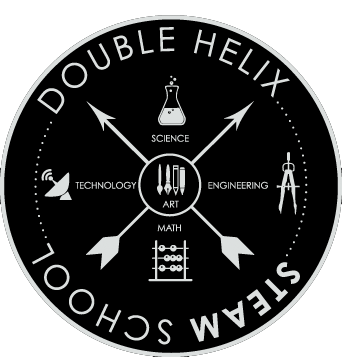
Frequently Asked Questions
What is STEAM?
Double Helix is a STEAM School. STEAM stands for Science, Technology, Engineering, Art, and Math, but it means so much more. It’s about innovation, creativity, critical thinking, problem-solving, collaboration, and other 21st Century skills students need to be successful. All of this is tied together with the arts in ways that naturally spark imagination and creativity.
What is the curriculum like?
Students take four academic classes: English Language Arts, Math, Science, and Social Studies. These classes are guided by state standards and enhanced by hands-on, project-based learning. We believe that children learn best by doing and that is what you will see in each classroom.
We often teach integrated, thematic units over the course of our semesters. There may be a culminating project for each theme and many supporting projects along the way. We take field trips and schedule speakers to enhance experiential learning. We focus on the integration between subject areas as they are in life outside of school.
We believe that creativity, collaboration, problem solving and developing critical thinking skills are as important as content. As such, we intentionally develop these 21st Century skills in all aspects of our curriculum.
Our elective classes are an integral part of what we do. We believe students should be able to explore a variety of activities and interests and our goal is to offer a plethora of diverse opportunities for them to do just that. These high-interest, hands-on classes are taught by our instructors, parents and members of our community and typically meet once per week. Students sign up for two classes per day and classes change each semester.
Did you say recess?
Yes! Children of all ages need to move. We know this. Eighth graders are still kids and they like to play as much as the 4th graders do. Students have an outdoor lunch/recess hour every day as well as a 10-minute outdoor morning snack break.
What about homework?
We don’t assign nightly homework. We believe that after-school time is for families, extracurricular activities, and downtime. We don’t subscribe to the idea that students have to work around the clock to prepare for the next level of schooling nor does the research support that. These are the last years of childhood; the worksheets can wait.
If a student falls behind, however, they may be asked to complete work at home. We do think kids should read nightly, and if they don’t know their math facts, they should practice them.
What about testing?
STANDARDIZED TESTING:
Students take the iReady diagnostic assessment for reading and math three times yearly. This benchmark assessment shows student progress toward meeting each skill/standard.
When done correctly, testing can be a good thing. Tests are supposed to provide us with a snapshot in time so that we can get an idea of students’ growth. We can then see how they compare to national norms. Most importantly for us, we can make sure that the teaching we are doing is transferring. That is, we need to make sure that a student who learned about slope by racing hot wheels is able to transfer that knowledge to a pencil and paper test question.
We can promise this: We will never sacrifice instructional time for test prep. We will never present a test as high stakes. We won't accelerate or alter instruction because test day is looming. We will never let the score we see on test results negate what we know about the child from daily experiences.
Testing can be a valuable tool and it is one we like to have in our toolbox. Parents may always elect to have their students opt out of testing.
OTHER TESTING:
In order to ensure that our instructional methods are working, we use a blend of formative and summative assessments. These can range from traditional quizzes/tests to portfolio assessments, to project-based learning. They allow teachers to ensure that we are hitting our mark by seeing evidence of student learning.
